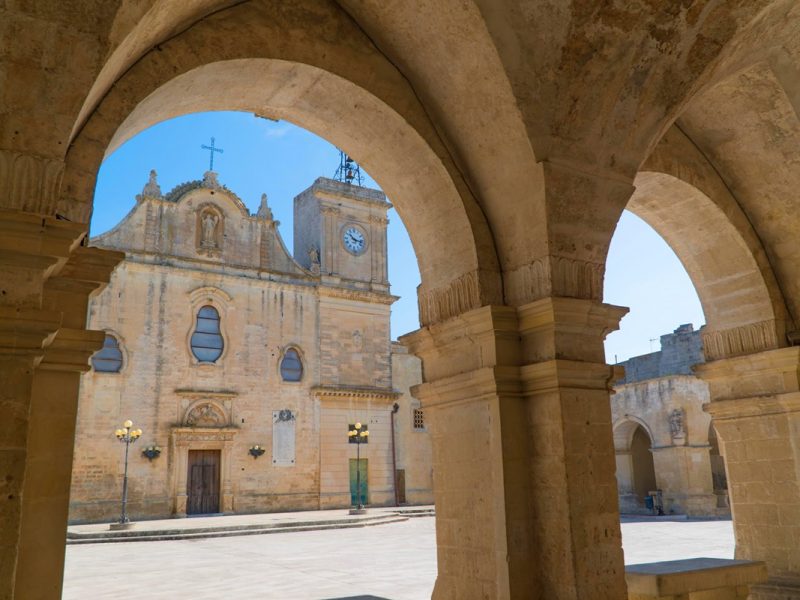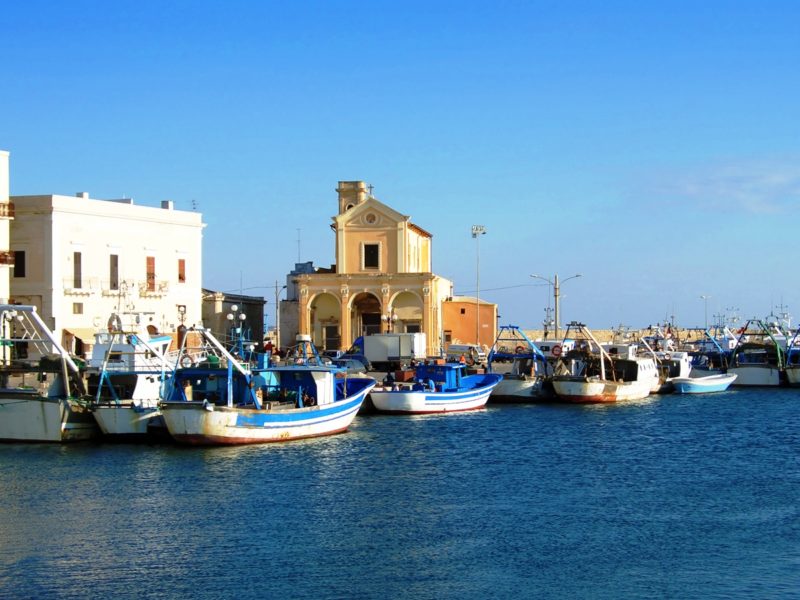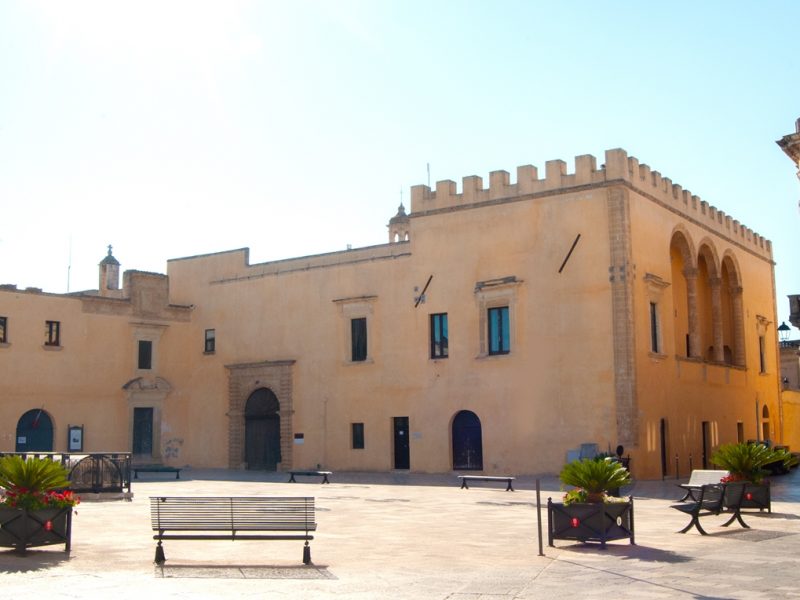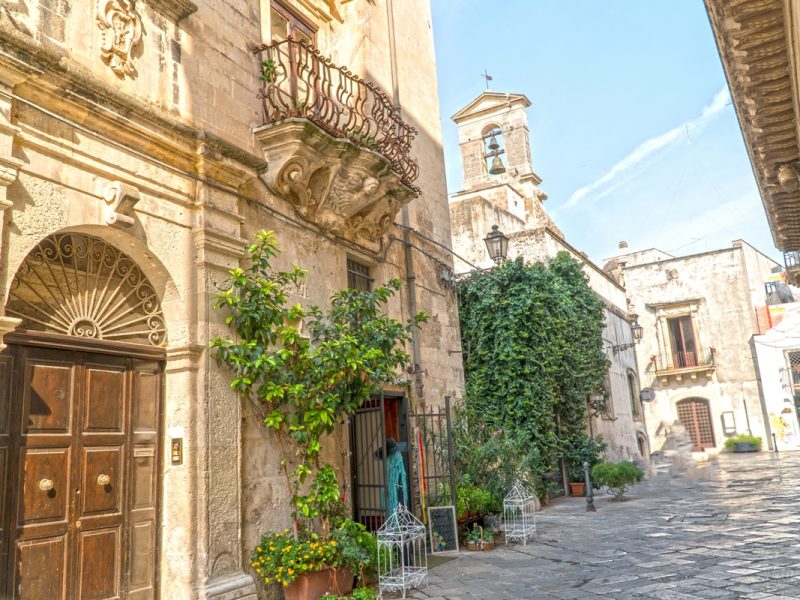The Borgo of Otranto
Otranto is a place of pure poetry, poetry that floats through the stone streets of the old city, past the artisan shops and little restaurants, the tempting aromas of traditional cooking wafting through the winding lanes. The historical center is a rosebud of white stone, blooming between the sea and the modern city. The ancient city walls are a time machine, transporting you to a place that is neither past nor present, where hidden corners reveal flowering balconies and elegant palaces of ancient stone, transmitting a thrilling magic.
Otranto has one hand reaching for the East, with its feet firmly planted in the West. Every morning it is illuminated by the delicate glow of the first dawn in Italy, from “Punta Palascia” to the “Cava di Bauxite”, along the Adriatic coast, where on a clear day, when the sea breeze sweeps away the morning fog, the mountains of Albania rise majestic on the horizon.
History
The darkest day in Otranto’s history will never be forgotten, black and deep as a bottomless pit, extinguishing the life of the city for one long, cruel year. It is 1480, and one hundred and fifty warships, with eighteen-thousand soldiers, armed to the teeth, swarm the port of Otranto; they are Ottoman Turks, the most feared predators of the Mediterranean sea. They attack with merciless brutality, but the population of Otranto resists with courage and determination, until they can take no more, and ravaged to the bone, to their very souls, they are forced to surrender the city to the Turks.
For a year these barbarians of the East ransack the city. With ruthless precision they dismember it limb from limb, destroying the very being of this exquisite jewel, its culture and its cherished symbol, the Basilian Monastery of San Nicola, which safeguarded the most extensive library in the western world, as well as the first College in history, hosting students from all over Europe. On the slopes of Mount Minerva eight hundred people are slaughtered, for the sole “crime” of refusing to convert to Islam. There is not one spark of humanity in these eighteen thousand soldiers, no warm blood runs in their veins.
Finally, the Aragons come to rescue the city, and are able to drive the Turks away. The barbarous inhumanity of the Muslim invaders was not able to conquer a people who made courage their emblem: today, the martyrs of Otranto are Saints, their bones are venerated in the Cathedral, while the precious volumes of the Basilian Library, saved from being destroyed by the fire in the convent, are now safeguarded in the most important museums of Europe, in Berlin, Moscow, and London. The “bombarde”, the white granite cannon balls the Turks used to bombard the city are still visible throughout the historical center, proud scars of a wound over which the city constructed a new life.
Otranto’s history is much more however, it is the past of a little town that became important because of its strategic port, which made it a bridge between the East and the West. In its Cathedral, twelve thousand crusaders were blessed on their way to the Holy Land, and when St. Francis returned from the Holy Land in 1219, he landed in Otranto, and was received with great honor.
Today, Otranto is one of the most important tourism destinations in Italy, with its beautifully conserved historical center, and the magnificent and generous natural paradise surrounding it. Its crystalline sea and its ancient borgo have made it one of the treasures of Salento, as well a UNESCO World Heritage site.
The Aragon Castle, il Castello Aragonese
The Aragon Castle was constructed by Alfonso d’Aragono at the end of the 1400’s, closing the ring of the defensive walls that had protected the city for centuries.
Where now stands an imposing palace, there was once a defensive construction dating back to the Swabian period, which was destroyed during the Turkish invasion. When the Aragons liberated Otranto in 1481, they constructed this fortified castle for defensive purposes, installing two cylindrical towers equipped with cannons, and successively, a “diamond point” tower. The castle was further protected by a moat that has never been filled with water, serving solely as a further deterrent to thwart invading enemies. Whoever was able to get as far as the moat was doomed to fall victim to cannon fire, which was engineered to strike in a wide, implacable radius, fired from various positions and angles in the wall, a sophisticated military technique that made it impossible for intruders to reach the castle.
The Castle of Otranto is not only known for its history, it was also immortalized in the novel by Walpole, “The Castle of Otranto”, which was written in 1764, and which plays an important role in international literature as the first Gothic novel ever written.
The Aragon Castle was conceived a structure of spartan utility, built to host warriors and weapons, today, however, it has become a cultural center, hosting exhibitions and important events within its ancient, fortified walls.
The Cathedral
The Cathedral of the Annunziata was built on the highest point of the borgo of Otranto, and is one of the largest churches in Puglia. It was constructed on a point of great historical importance, as it was once the location of a Roman “domus” (noble home), a Messapian village and a Paleo-Christian temple.
The Cathedral was constructed at the height of the Middle Ages, between 1080 and 1088, and the decorations in its interior bear witness to numerous styles and influences, from the Baroque portal of the Romanic façade in Lecce stone, to the rose window in Sicilian Gothic style dating back to the Renaissance.
The interior is divided by two rows of ample columns that define the central aisle, with flooring covered by the largest mosaic in Europe: an intricate depiction of the Tree of Life, full of mysterious significance, which still today brings numerous researchers to Otranto to study and explore its secrets.
At the end of the central nave is the Palatine Chapel, where the remains of six hundred of the martyrs of Otranto are held. The relics of the other two hundred saints were transferred to the Church of Santa Caterina in Formello, Napoli, in the Chapel dedicated to “Blessed Antonio Primaldo and his martyred companions of Otranto”.
Behind the central altar is the massive stone upon which the eight hundred martyrs were decapitated. Legend has it that the first victim, Antonio Primaldo, miraculously remained on his feet, without his head, all throughout the executions.
The ceilings of the Cathedral are in Moorish style, a rare decorative choice in the Province of Lecce, painted in gold on a black and white background.
The entire Cathedral is supported by forty-two monolithic columns located in the crypt, each completely different from the other, with themes related to the mosaics above, arranged in a disorienting fashion, in an Arabic style that gives the visitor the sense of being in a mosque.
The Bauxite Quarry, Punta Palascia.
The ex-Bauxite Quarry is located a few kilometers from Otranto, immersed in a pine forest, with the sea in a thousand shades of blue shimmering in the background. This magical place is certainly one of the most photographed places in Salento. Until 1976, the quarry extracted bauxite, a mineral from which aluminum is derived. At the cessation of the mining activity, the groundwater was absorbed into the subsoil and formed a phosphorescent, emerald green lake, creating a striking contrast with the Siena red of the rocky walls and the deep green of the surrounding woods.
The Bauxite Quarry, today called Orte Pond, is one of the most unique and evocative places in Salento. A little farther along, we find the Lighthouse of Punta Palascia, the easternmost point in Italy, where you can also visit the “Museo del Mare”, the Sea Museum.
Torre Sant’Emiliano, “la Marmitta dei Giganti” The Giants’ Bowl
Along the coast of Porto Badisco, you can admire the stark form of Torre Sant’ Emiliano, a tower on the cliffs above the sea, majestic in the solitude of the coastal landscape.
Near the tower is a truly unusual geological rarity, “La Marmitta dei Giganti”, the Giants’ Bowl. This is the name given to the stone erosions caused by water that forms actual bowls in the stone. Usually this phenomena is found near rivers and waterfalls and rarely in coastal waters. In Salento there are two, one near the Ciolo bridge farther south, and the other here, at Torre Sant’Emiliano, where, with the passing of time, Nature has outdone herself and has modeled a perfectly formed stone ball inside the enormous “bowl”, creating a truly unique natural masterpiece.
I Laghi Alimini, the Alimini Lakes
Moving north up the coast toward Torre dell’Orso, we find the Alimini Lakes, a natural park with breathtaking panoramas, protected by the Puglia Region.
The Alimini Lakes are comprised of two lakes, Lago Grande, a large salt water lake surrounded by rocks and pine woods, and a small lake, called Le Fontanelle, (the springs), created by freshwater springs and rain water, which are connected to each other via a little canal.
The Alimini Lakes protect an ecosystem of extremely rare flora and fauna: marsh orchids, water chestnuts and venus fly traps, the carnivorous plants that open and swallow any insect that they come in contact with. Rare aquatic birds such as Eurasian Coots and Pochards live in this stupendous natural habitat.
The Mosaic of Otranto and the Search for the Holy Grail
In 1163, work began on what is considered the largest mosaic in Europe, and which has also earned a place of prestige on the list of the largest mosaics in the world. It was created under the tutelage of the Basilian monk, Pantaleone, and depicts a gigantic Tree of Life, supported by two elephants, symbols of Christian strength. Within the mosaic there are scenes from the Old Testament, mythological animals, zodiac signs and even portrayals of King Arthur, as well as scenes from daily life.
It is divided into three parts and covers the entire expanse of the central nave, representing an allegorical history of the human race. The Mosaic of Otranto is full of esoteric symbols and meanings, and has been linked to numerous myths and legends. The most common is that the mosaic contains the hidden message of the Holy Grail. The fact that the maestro of the work was a monk, that it describes elements related to the Tales of Camelot and the Crusades and that the styles and themes are not present in any of the other churches nearby, supports this hypothesis. It is also of interest that the Turkish invaders of 1480 chose the Cathedral as their encampment, and that it was the only monument in Otranto spared being damaged or destroyed. Could the invaders have been searching for the Holy Grail as well? It is a mystery that remains hidden in the tomb of the monk, Pantaleone.
La Grotta dei Cervi, The Deer Cave
It is the year 1970, and five men are on the rocky shore of Porto Badisco when they notice a strange accumulation of stones in a ravine. The decide to investigate, and moving them, enter a series of corridors and galleries, leading to a spacious room completely covered in pictograms and cave paintings: what is known today as the “Grotta dei Cervi”, the Deer Cave.
For five days the cave is explored, photographed, and blocked off for safety, but no one who comes in contact with this environment realizes they are in one of largest monuments of post-Paleolithic cave paintings ever discovered.
A series of tunnels leads to the cave, which is an actual temple, modeled to fulfill the needs of those who lived there, with stone walls to prevent flooding, stairways sculpted in the tufo stone and designs painted in earth-red and tar-black covering the walls. Detailed scenes of deer hunts alternate with dancing women, shamans, and meetings of tribal leaders from far-away lands. There are also stylized human figures, zig-zags, and the letter S, repeated in continuation throughout the entire cave.
The group of speleologists who discovered the cave called it “The Cave of Aeneas” because of the legend of the Trojan hero who landed in Porto Badisco after the Trojan Wars, but the cave is located in the ancient land of deer hunters, and it for them that the cave is actually named.
The Deer Cave is one of the treasures of Salento, but it is also one of the least valorized and least known. For more than forty-seven years a high fence has separated this fascinating world, frozen in time over 5,000 years ago, from our constantly changing modern age.
The Legend of the Castle
Every castle has its ghost, and the Castle of Otranto is no exception. In fact, some swear they have witnessed a strange presence moving in diamond-point tower and inside the walls of the castle: this would be the spirit of Donna Teresa de Azevedo, a Spanish noblewoman, who died at a young age, leaving behind her grief-stricken husband, the ruler of Otranto. To honor her, the warlord constructed a memorial tomb in Lecce stone in the chapel of the castle. On the walls there is a fresco depicting an aristocrat, said to be Donna Teresa’s husband, who had himself painted there so he could always watch over her.
In 2014, the ghost of Otranto captured the attention of the “Associazione Italiana Ricercatori del Mistero”, (the Italian Association of Mystery Research): with the mayor of Otranto’s permission, a team installed themselves in the Aragonese castle, and using specialized equipment, recorded voices and anomalous sounds as well as sudden thermal drops in temperature in specific points of the room. Regardless of these interesting findings, given the delicacy of paranormal research, the investigators have remained cautious in furnishing a final diagnosis.
Ennio Capasa
Ennio Capasa was born in Otranto in 1960. After receiving his diploma from the Artistic high school of Lecce, he moved to Milan to study at the Accademia di Brera. He then began a successful career as an international designer in Tokyo, Paris and Milan. In 1986, he presented his fisrt collection: COSTUME NATIONAL. In 2005, he collaborated with Ducati designing limited edition accessories. He currently lives in Milan.
Ettore d’Amore
Ettore d’Amore was a marshal in the Italian Military Police, “Arma dei Carabinieri”. He was awarded the Memorial Civil Medal of Honor for having confronted and neutralized an attacker, even though he had been mortally wounded.
_______________________________________
Do you know other famous people of this Borgo? Contact us!
Do you know typical recipes of this Borgo? Contact us!

 Italiano
Italiano
 Deutsch
Deutsch
























